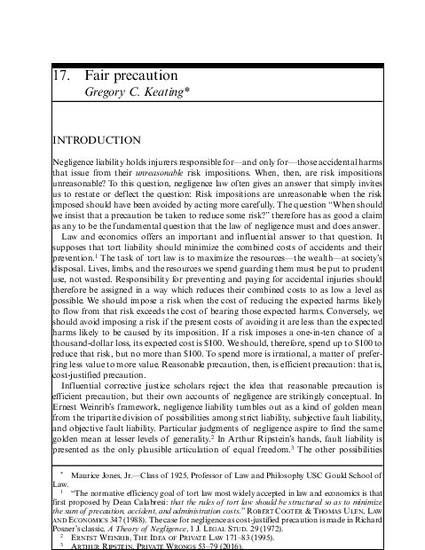
Contribution to Book
Fair Precaution
Research Handbook on Private Law Theory
(2020)
Abstract
This chapter sketches a general framework which explains why questions of fairness have a natural salience when the imposition of risks of harm by some on others is at issue, and it applies that conception to major aspects of negligence law. Fairness comes to the fore because risk impositions require us to compare (1) what those who impose the risks stand to gain with (2) what those upon whom the risks are imposed stand to lose. Determinations of due care reconcile competing claims of liberty and security—for a plurality of persons. Fairly reconciling liberty and security requires reconciling them on terms that are justifiable both to those who impose risks and to those upon whom they are imposed. This, in turn, requires comparing the benefits and burdens of risk impositions in terms of their objective urgency, assessing the burdens and benefits of risk impositions qualitatively, and assigning a certain priority to the avoidance of harm. The framework is used to explicate the concept of due care articulated by the Hand Formula; to illuminate the circumstance where risks are imposed with a “community of risk”; and to situate subordinate doctrines of due care such as custom, statutory negligence, and jury adjudication. Brief contrasts are drawn with both law and economic approaches to justified precaution as efficient precaution, and with versions of corrective justice which see negligence liability falling out of a universe of conceptual possibilities where it holds the high ground of a golden mean.
Keywords
- negligence,
- rights,
- interests,
- harm,
- precaution,
- risk,
- fairness,
- liberty,
- security,
- Arthur Ripstein,
- Ernest Weinrib
Disciplines
Publication Date
December 17, 2020
Citation Information
Gregory C. Keating. "Fair Precaution" Research Handbook on Private Law Theory (2020) p. 286 - 302 Available at: http://works.bepress.com/gregorykeating/39/
